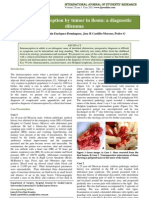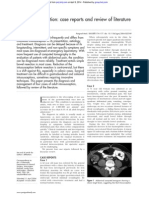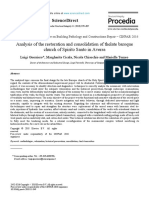Tarlac State University
Tarlac State University
Uploaded by
Jenica DancilCopyright:
Available Formats
Tarlac State University
Tarlac State University
Uploaded by
Jenica DancilCopyright
Available Formats
Share this document
Did you find this document useful?
Is this content inappropriate?
Copyright:
Available Formats
Tarlac State University
Tarlac State University
Uploaded by
Jenica DancilCopyright:
Available Formats
Tarlac State University College of Nursing Lucinda Campus, Brgy.
Ungot, Tarlac City
Narrative Charting on Appendectomy
In Partial Fulfillment of the requirements in NCM 103 RLE
Presented to: Raul Franco G. Tomas RN, MAN Clinical Instructor
Presented By: Rosemarie M. Guiang BSN IIIA- Group A1
TABLE OF CONTENTS
I INTRODUCTION
II DEMOGRAPHIC DATA
III PRESENT HEALTH HISTORY
IV NARRATIVE CHARTING
V ANATOMY AND PHYSIOLOGY
VI PATHOPHYSIOLOGY
I INTRODUCTION Appendectomy is said to be the most common emergent surgical procedure performed worldwide, with appendicitis accounting for approximately 1 million hospital days annually and remains to be only curative treatment for appendicitis. Appendicitis is an inflammation of the vermiform appendix that develops most commonly in adolescents and young adults. (Medical-Surgical Nursing, Black, Hawks and Keene, 6th edition). No single sign, symptom, or diagnostic test accurately confirms the diagnosis of appendiceal inflammation in all cases, and the classic history of anorexia and periumbilical pain followed by nausea, right lower quadrant (RLQ) pain, and vomiting occurs in only 50% of cases. It has the potential for severe complications, including perforation or sepsis, and may even cause death. It has slight male preponderance of 3:2 in teenagers and young adults; in adults, the incidence of appendicitis is approximately 1.4 times greater in men than in women. The incidence of primary appendectomy is approximately equal in both sexes. Lower incidence of appendicitis is also found in Asian and African Countries because of the dietary habits in these areas. The incidence of appendicitis gradually rises from birth, peaks in the late teen years, and gradually declines in the geriatric years. The mean age when appendicitis occurs in the pediatric population is 6-10 years. Lymphoid hyperplasia is observed more often among infants and adults and is responsible for the increased incidence of appendicitis in these age groups. Younger children have a higher rate of perforation, with reported rates of 50-85%. The median age at appendectomy is 22 years. Although rare, neonatal and even prenatal appendicitis have been reported. Clinicians must maintain a high index of suspicion in all age groups.( http://emedicine.medscape.com/article/773895overview#a0156)
For the past years appendicitis is known as a common and urgent surgical illness with protean manifestations, generous overlap with other clinical syndromes, and significant morbidity, which increases with diagnostic delay. But recent researches had found out that Delay in Performing Appendectomy is not Associated With Adverse Outcomes in a study conducted by Angela M. Ingraham, M.D., M.S., of the American College of Surgeons (ACS), Chicago, and colleagues who studied data from 32,782 patients treated at hospitals participating in the ACS National Surgical Quality Improvement Program who underwent an appendectomy for acute appendicitis between 2005 and 2008. After 30 days, there were no significant differences in complications or deaths between the three groups.(Archives of journals) But still Appendectomy remains the only curative treatment of appendicitis since no medical treatment has been discovered yet to replaced appendectomy for treating appendicitis. IMPORTANCE OF THE STUDY The goal of using the study method is to describe as accurately as Surgery: JAMA/Archives
possible the most complete, specific and comprehensible description of the case. It is hoped that interrelation of each stage of the process will be identified and by conducting such kind of case study will developed or uplift our knowledge , skills and future practice. it is a way of reflecting what has been learned through the application of all what has been learned and while being acquainted with other new experiences. I have choose to come up with this case study because I want to learn about this condition, since I do have only few knowledge regarding this condition and since we have not still have a discussion with such case.
II DEMOGRAPHIC DATA Name: Boy Labo Age: 27 Sex: Male Date of Birth: January 31, 1984 Address: Brgy, Walo-Walo, Siyam City Nationality: Filipino Place of Admission: Tarlac Provincial Hospital Date Admitted: August 12, 2011 Chief Complaint: Right Lower Quadrant Pain Ward: Surgical Ward Attending Physician: Dr. House Chief complaint: Right Lower Quadrant pain Final Diagnosis: Acute Appendicitis
III PRESENT HEALTH HISTORY Patient experienced a severe pain at his abdomen which started at the area around his periumbilical area shifted to right lower quadrant region. He was rushed to the hospital and was admitted at the surgery ward and was diagnosed with acute appendicitis.
IV NARRATIVE CHARTING Name: Boy Labo Age: 27 years old Birthday: January 31, 1984 Case No: 179163 Address: Brgy. Walo-walo, Siyam City Chief complaint:Right Lower Quadrant Pain Medical Diagnosis: Acute appendicitis Attending physician: Dr. House Date: August 12, 2011 Admitted at 10:35 p.m., a 27 years old male from surgical ward via stretcher with a chief complaint of Right Lower Quadrant pain. Concious and coherent With ongoing D5LR 1L, received at 950 cc level inserted at Right metacarpal vein regulated at 30 drops per minute, intact and infusing well. Explained the procedure and obtained inform consent (by the physician) Transferred to Operating table Administered Bupivacaine thru Subarachnoid Block >Turned to left side with knee touching the chest > Skin on the lumbar area is cleaned > Palpated the subarachnoid space > inserted the needle > Confirmed the insertion to the subarachnoid space with the flow of a clear iquid > Administered anesthesia Turned to supine position Inserted Foley catheter Placed Pulse oximeter in the index finger of the right hand
Administered Oxygen Abdomen was prepped and draped Surgical team scrubbed Instruments are prepared and initial instrument and sponge count done An incision is made in the right lower abdomen with a knife(skin) followed by a cautery: >Identified the appendix > The mesoappendix is separated off of the appendix, clamped and tied off > The remainder of the appendix is clamped, cut and removed > Repeat sponge and instrument count done >Final Sponge and instrument count done >Skin layers are sutured back. Cleaned the incision site Applied povidine iodine Applied dressing Removed pulse oximeter and oxygen Collected specimen and placed in a specimen bottle Transferred to PACU VI ANATOMY AND PHYSIOLOGY
Appendix is a small, finger-like appendage about 10 cm (4 inches) long that is attached to the cecum just below the ileocecal valve. The appendix fills with food and empties regularly into the cecum. Because it empties inefficiently and its lumen is small, it is prone to obstruction and particularly vulnerable to infection such as ppendicitis.(Brunner and Suddharta, 10th edition, medicalsurgical nursing) The appendix is a wormlike extension of the cecum and, for this reason, has been called the vermiform appendix. The appendix appears during the fifth month of gestation, and several lymphoid follicles are scattered in its mucosa. Such follicles increase in number when individuals are aged 8-20 years. Normal appendix; barium enema radiographic examination. A complete contrast-filled appendix is observed (arrows), which effectively excludes the diagnosis of appendicitis. The appendix is contained within the visceral peritoneum that forms the serosa, and its exterior layer is longitudinal and derived from the taenia coli; the deeper, interior muscle layer is circular. Beneath these layers lies the submucosal layer, which contains lymphoepithelial tissue. The mucosa consists of columnar epithelium with few glandular elements and neuroendocrine argentaffin cells. Taenia coli converge on the posteromedial area of the cecum, which is the site of the appendiceal base. The appendix runs into a serosal sheet of the peritoneum called the mesoappendix, within which courses the appendicular artery, which is derived from the ileocolic artery. Sometimes, an accessory appendicular artery (deriving from the posterior cecal artery) may be found. Appendiceal vasculature The vasculature of the appendix must be addressed to avoid intraoperative hemorrhages. The appendicular artery is contained within the
mesenteric fold that arises from a peritoneal extension from the terminal ileum to the medial aspect of the cecum and appendix; it is a terminal branch of the ileocolic artery and runs adjacent to the appendicular wall. Venous drainage is via the ileocolic veins and the right colic vein into the portal vein; lymphatic drainage occurs via the ileocolic nodes along the course of the superior mesenteric artery to the celiac nodes and cisterna chyli. Appendiceal location The appendix has no fixed position. It originates 1.7-2.5 cm below the terminal ileum, either in a dorsomedial location (most common) from the cecal fundus, directly beside the ileal orifice, or as a funnel-shaped opening (2-3% of patients). The appendix has a retroperitoneal location in 65% of patients and may descend into the iliac fossa in 31%. In fact, many individuals may have an appendix located in the retroperitoneal space; in the pelvis; or behind the terminal ileum, cecum, ascending colon, or liver. Thus, the course of the appendix, the position of its tip, and the difference in appendiceal position considerably changes clinical findings, accounting for the nonspecific signs and symptoms of appendicitis. VII PATHOPHYSIOLOGY Book Based Obstruction of the appendix (by fecalith, lymph node, tumour, foreign objects) Inflammation Increase intraluminal pressure Distention of the Appendix Decrease venous drainage Blood flow and oxygen restriction to the appendix Bacterial Invasion of the Blood wall
Necrosis of the appendix Source: Medical-Surgical Nursing: Black, Hawks and Keene, 6th edition
Patient Based: Modifiable: Diet: Low in Fiber Non-modifiable: >Age: 27 years old (peak incidence 20-30 years old) >Male (1.4 times greater in male)
Fecal obstruction, swelled lymph nodes, bacteria viruses, protozoa etc. Occlusion of Appendix by Fecalith Decreased flow/drainage of mucosal secetions Increased ILP in the appendix Vasocongestion SWELLING and PAIN
Decreased perfusion in the appendix Hypoxia in the appendix Appendix starts to be necrotic; Bacteria invade the appendix Disruption of Cell Membrane of Appendix Start of Inflammatory Process
Release of Chemical Activation of vomiting inflammation mediators of the Appendix
Impaired tissue integrity
Tissue trauma infection
Risk for
Appendectomy
Nociceptors in the dermis Start of inflammatory process
disruption of the cell membrane sends impulse to CNS
Release of prostaglandin, bradykinin, Histamine, leukotrienes and other che Mical mediatorsa PAIN AND SWELLING
You might also like
- My Dinner With AndreDocument18 pagesMy Dinner With Andremaison_orion100% (1)
- Comprehension Cliffhanger StoriesDocument80 pagesComprehension Cliffhanger Storiesapi-301260764100% (3)
- A Case Study On Acute AppendicitisDocument56 pagesA Case Study On Acute AppendicitisIvy Mae Evangelio Vios92% (13)
- DhaDocument17 pagesDhachakkykichu100% (4)
- Background: Pediatric AppendicitisDocument15 pagesBackground: Pediatric AppendicitisnikkitaihsanNo ratings yet
- Journal AslinyaDocument11 pagesJournal AslinyainNo ratings yet
- A Case of Primary Actinomycosis and Secondary Eumycetoma in Anterior Abdomen Wall - A Case ReportDocument7 pagesA Case of Primary Actinomycosis and Secondary Eumycetoma in Anterior Abdomen Wall - A Case ReportHAMMADNo ratings yet
- Abdomen FungusDocument7 pagesAbdomen FungusHAMMADNo ratings yet
- APPENDICITIS (Surgical Emergency)Document14 pagesAPPENDICITIS (Surgical Emergency)mkongclaudine776No ratings yet
- 2 Semester 1 Major Patho AnatoDocument49 pages2 Semester 1 Major Patho AnatoManushi HenadeeraNo ratings yet
- Anatomy, Abdomen and Pelvis, Appendix: Publication DetailsDocument5 pagesAnatomy, Abdomen and Pelvis, Appendix: Publication DetailsAndiNo ratings yet
- AppendicitisDocument36 pagesAppendicitisPetro MyronovNo ratings yet
- Capitol University College of Nursing: Acute AppendicitisDocument28 pagesCapitol University College of Nursing: Acute AppendicitisCatherine Milar Descallar100% (1)
- Sabitson - Appendiks EngDocument17 pagesSabitson - Appendiks Engzeek powerNo ratings yet
- Adult Intussussception Int J Student Res 2012Document3 pagesAdult Intussussception Int J Student Res 2012Juan De Dios Diaz-RosalesNo ratings yet
- Appendicitis EditDocument11 pagesAppendicitis EditAnjung WibiksanaNo ratings yet
- Appendicitis: Dr. Aplin I, SPBDocument12 pagesAppendicitis: Dr. Aplin I, SPBAyu Kusuma NingrumNo ratings yet
- AppendicitisDocument4 pagesAppendicitisFebriyana SalehNo ratings yet
- Appendicitis NCSDocument25 pagesAppendicitis NCSZyrah Ziska ZafraNo ratings yet
- A Rare Case of Colon Cancer in A Young Patient: A Case Report and Literature ReviewDocument5 pagesA Rare Case of Colon Cancer in A Young Patient: A Case Report and Literature ReviewIJAR JOURNALNo ratings yet
- AppendicitisDocument35 pagesAppendicitisBoichong LotzemNo ratings yet
- Acute Appendicitis in Adults Clinical Ma PDFDocument27 pagesAcute Appendicitis in Adults Clinical Ma PDFAntonio Zumaque CarrascalNo ratings yet
- Theme No1 Acute Appendicitis, Peritonitis in Children. CompilersDocument20 pagesTheme No1 Acute Appendicitis, Peritonitis in Children. CompilersCynthia GNo ratings yet
- Acute Appendicitis in Adults - Clinical Manifestations and Differential Diagnosis - UpToDateDocument9 pagesAcute Appendicitis in Adults - Clinical Manifestations and Differential Diagnosis - UpToDateSebastian CamachoNo ratings yet
- Bedah - Prekas AppendisitisDocument15 pagesBedah - Prekas AppendisitisALfianca Yudha RachmandaNo ratings yet
- Successful Treatment of A 14-Year-Old Patient With Intestinal Malrotation With Laparoscopic Ladd Procedure: Case Report and Literature ReviewDocument5 pagesSuccessful Treatment of A 14-Year-Old Patient With Intestinal Malrotation With Laparoscopic Ladd Procedure: Case Report and Literature ReviewHendry JohannesNo ratings yet
- Acute AppendicitisDocument30 pagesAcute AppendicitisJohn RyanNo ratings yet
- Acute AppendicitisDocument23 pagesAcute AppendicitisSandie Daniel GabalunosNo ratings yet
- 231 PDFDocument12 pages231 PDFAgus KarsetiyonoNo ratings yet
- APENDICITIS Fischers Mastery of Surgery 7th ING PDFDocument33 pagesAPENDICITIS Fischers Mastery of Surgery 7th ING PDFMichel RamirezNo ratings yet
- Appendectomy NCPDocument4 pagesAppendectomy NCPPersha Perez ArabaniNo ratings yet
- Acute Appendicitis in Adults 202302Document13 pagesAcute Appendicitis in Adults 202302laura correaNo ratings yet
- Jurnal TB AbdomenDocument4 pagesJurnal TB AbdomenbelaNo ratings yet
- Acute Appendicitis (Avendano, RM)Document23 pagesAcute Appendicitis (Avendano, RM)rica avendañoNo ratings yet
- Appendicitis: Mark W. Jones Hassam Zulfiqar Jeffrey G. DeppenDocument7 pagesAppendicitis: Mark W. Jones Hassam Zulfiqar Jeffrey G. DeppenAndi HairunNo ratings yet
- Tuberculous Ileal Perforation in Post-Appendicectomy PeriOperative Period: A Diagnostic ChallengeDocument3 pagesTuberculous Ileal Perforation in Post-Appendicectomy PeriOperative Period: A Diagnostic ChallengeIOSRjournalNo ratings yet
- Appendicitis InfiltratesDocument14 pagesAppendicitis InfiltratesRiza Rahmalia100% (1)
- AppendicitisDocument13 pagesAppendicitisNyakie MotlalaneNo ratings yet
- Appendicitis: San Roque Extension, Roxas City, Capiz 5800Document10 pagesAppendicitis: San Roque Extension, Roxas City, Capiz 5800GUEZIL JOY DELFINNo ratings yet
- Acute Appendicitis: Michael Alan Cole Robert David HuangDocument10 pagesAcute Appendicitis: Michael Alan Cole Robert David HuangandreaNo ratings yet
- Common Anorectal Conditions:: Part I. Symptoms and ComplaintsDocument8 pagesCommon Anorectal Conditions:: Part I. Symptoms and ComplaintsSi vis pacem...No ratings yet
- Case StudyDocument57 pagesCase StudyEdmarkmoises ValdezNo ratings yet
- Appendectomy Appendicitis Case Study1Document18 pagesAppendectomy Appendicitis Case Study1Los Devio100% (1)
- AppendicitisDocument14 pagesAppendicitisMary Joy BunuanNo ratings yet
- 18-Month-Old Boy With Abdominal Pain and Rectal Bleeding BackgroundDocument5 pages18-Month-Old Boy With Abdominal Pain and Rectal Bleeding Backgroundcamille nina jane navarroNo ratings yet
- Postgrad Med J 2005 Yalamarthi 174 7Document5 pagesPostgrad Med J 2005 Yalamarthi 174 7Novendi RizkaNo ratings yet
- Acute Appendicitis in Adults: Clinical Manifestations and DiagnosisDocument37 pagesAcute Appendicitis in Adults: Clinical Manifestations and DiagnosisDaniela MuñozNo ratings yet
- Grand Case Pres - Transverse Vaginal Septum..Document32 pagesGrand Case Pres - Transverse Vaginal Septum..Gio LlanosNo ratings yet
- Acute AppendicitisDocument9 pagesAcute AppendicitisSyarafina AzmanNo ratings yet
- Vermiform AppendixDocument4 pagesVermiform AppendixHarun NasutionNo ratings yet
- 1.7B AppendixDocument4 pages1.7B AppendixDulce Kriselda E. FaigmaniNo ratings yet
- Appendicitis Nursing NotesDocument2 pagesAppendicitis Nursing NotesFreeNursingNotes33% (3)
- Pediatric Clinics of North America IIDocument54 pagesPediatric Clinics of North America IIkarenNo ratings yet
- Appendicitis: Differential Diagnoses & Workup Treatment & Medication Follow-UpDocument12 pagesAppendicitis: Differential Diagnoses & Workup Treatment & Medication Follow-UpnetonetinNo ratings yet
- Acute Appendicitis of The Appendiceal StumpDocument3 pagesAcute Appendicitis of The Appendiceal StumpXavier JarrínNo ratings yet
- Does This Child Have AppendicitisDocument6 pagesDoes This Child Have Appendicitispoochini08No ratings yet
- Gi 1Document3 pagesGi 1Syifa' FauziyahNo ratings yet
- Perforated Appendicitis: Shahid Sadoughi University of Medical Sciense, Yazd, IranDocument17 pagesPerforated Appendicitis: Shahid Sadoughi University of Medical Sciense, Yazd, IranEloisamay Barrameda EspirituNo ratings yet
- Jurnal Bedah 2Document5 pagesJurnal Bedah 2nafamaulidinaNo ratings yet
- Appendicitis Casestudy PDFDocument19 pagesAppendicitis Casestudy PDFayanams4002No ratings yet
- Extra Pelvic Endometriosis: Double Ileal and Ileo-Caecal Localization Revealed by Acute Small Bowel Obstruction, A Clinical CaseDocument9 pagesExtra Pelvic Endometriosis: Double Ileal and Ileo-Caecal Localization Revealed by Acute Small Bowel Obstruction, A Clinical CaseIJAR JOURNALNo ratings yet
- Appendectomy Case ReportDocument42 pagesAppendectomy Case ReportDane CunananNo ratings yet
- Appendicitis Unveiled: A Holistic Exploration from Historical Perspectives to Integrative SolutionsFrom EverandAppendicitis Unveiled: A Holistic Exploration from Historical Perspectives to Integrative SolutionsNo ratings yet
- Mazuri 5E5L StudyDocument9 pagesMazuri 5E5L StudyLawrence TancincoNo ratings yet
- 9th Class Maths PDFDocument20 pages9th Class Maths PDFsrinivasbudati100% (2)
- IMTGT Transformation To Digital Economy?: Unicorns, Transformation and The Internet of ThingsDocument5 pagesIMTGT Transformation To Digital Economy?: Unicorns, Transformation and The Internet of ThingsWilliam AnthonyNo ratings yet
- A Review of Bioactive Plant Polysaccharides: Biological Activities, Functionalization, and Biomedical ApplicationsDocument31 pagesA Review of Bioactive Plant Polysaccharides: Biological Activities, Functionalization, and Biomedical ApplicationsNanNo ratings yet
- Speaking TestDocument3 pagesSpeaking Testnohuynh.31231026609No ratings yet
- Professional LED Lighting Catalogue April 2014Document109 pagesProfessional LED Lighting Catalogue April 2014Jeffrey Valenzuela100% (1)
- English Essay UpsrDocument11 pagesEnglish Essay UpsrShalini BhaskaranNo ratings yet
- Nursing 3Document48 pagesNursing 3Ranjitha MohanNo ratings yet
- Accidental PoisoningDocument3 pagesAccidental PoisoningBRUELIN MELSHIA MNo ratings yet
- Dbms Question PaperDocument24 pagesDbms Question PaperVishal VNo ratings yet
- Analysis of The Restoration and Consolidation of Thelate Baroque Church of Spirito Santo in AversaDocument11 pagesAnalysis of The Restoration and Consolidation of Thelate Baroque Church of Spirito Santo in AversaFarid WilchezNo ratings yet
- AmazingRooftops-3-TR-AssessmentPackage INGLES 3 PRIMARIADocument24 pagesAmazingRooftops-3-TR-AssessmentPackage INGLES 3 PRIMARIABelen Martin Julian MartinNo ratings yet
- Chapter 22 Exile in DapitanDocument4 pagesChapter 22 Exile in DapitanDwayne Aldrech Pecante100% (1)
- Samarin Bana by WWW - Dlhausanovels.com - NGDocument256 pagesSamarin Bana by WWW - Dlhausanovels.com - NGFalmata Bukar koloNo ratings yet
- Invitation. Mundus SlavicusDocument2 pagesInvitation. Mundus Slavicustihomir.djordjevic9No ratings yet
- ORGS 1136 - Week 3, Chapter 3 Notes ORGS 1136 - Week 3, Chapter 3 NotesDocument3 pagesORGS 1136 - Week 3, Chapter 3 Notes ORGS 1136 - Week 3, Chapter 3 NotesTara FGNo ratings yet
- Santiago Vs PioneerDocument2 pagesSantiago Vs PioneerKaye Patrice Andes ApuyanNo ratings yet
- Inorganic Chemistry ExpDocument46 pagesInorganic Chemistry Exppc355chyi100% (3)
- Reflectiveessay AshleyhancockDocument5 pagesReflectiveessay Ashleyhancockapi-273174764No ratings yet
- 01 - Code of Ethics - DocxDocument3 pages01 - Code of Ethics - DocxCee SNo ratings yet
- Zno WritingDocument40 pagesZno WritingНаталія Галамага100% (2)
- CHV 2O Course Outline 2022 - 2023 MartinDocument3 pagesCHV 2O Course Outline 2022 - 2023 MartinOcean CherneskeNo ratings yet
- Colonialism Competition Makira PDFDocument35 pagesColonialism Competition Makira PDFIgnacio Fernández De MataNo ratings yet
- Appendicitis and Peritonitis 1Document21 pagesAppendicitis and Peritonitis 1chrisyenNo ratings yet
- CSU CICT Student Portal Management SystemDocument22 pagesCSU CICT Student Portal Management SystemTrxtr GiananNo ratings yet
- OO3 - CESC - 2nd ExamsDocument15 pagesOO3 - CESC - 2nd ExamsJacquesse Mackenzie LicoNo ratings yet
- Rejection Sensitivity As An Interpersonal Vulnerability: Janina Pietrzak, Geraldine Downey, and Ozlem AydukDocument23 pagesRejection Sensitivity As An Interpersonal Vulnerability: Janina Pietrzak, Geraldine Downey, and Ozlem AydukBrunoNo ratings yet

























































































